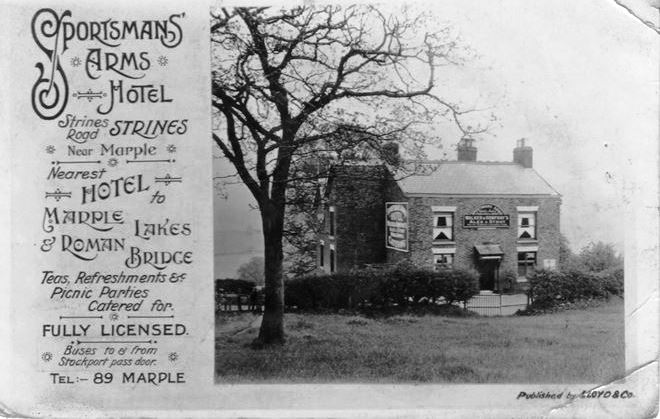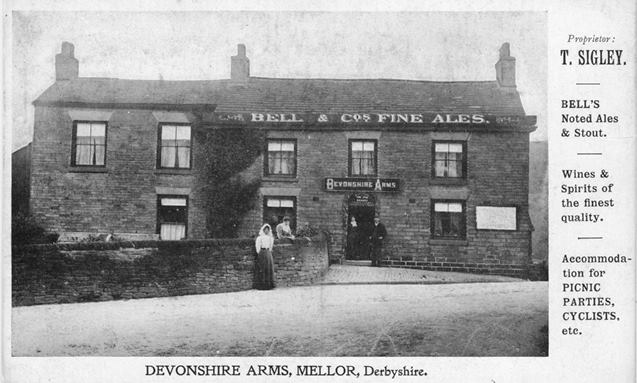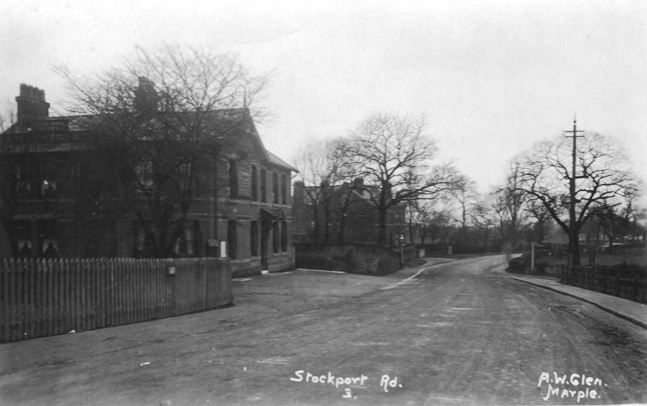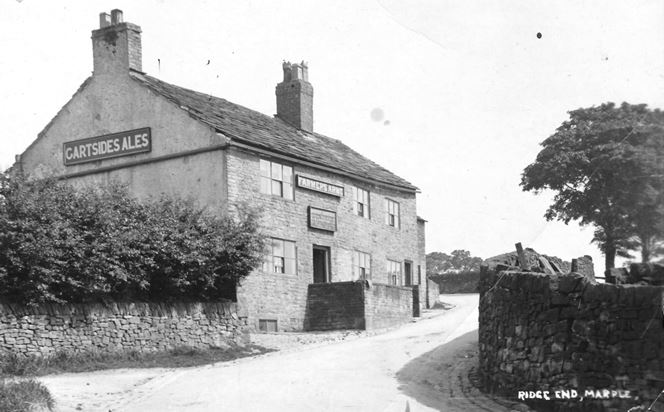Sportsman’s Arms, Strines
The turnpike road from Marple to New Mills (Strines Road) opened in 1801. In 1805, seeing a business opportunity, John Braddock bought a plot of land built the Sportman’s Arms and was granted his first alehouse licence.

It was ideally situated for workers from Strines Print Works, boatmen travelling along the Peak Forest Canal and passing road traffic; no wonder it had its own brew house and stables. In 1821, Joel Sidebottom became landlord but kept his ‘day job’ as a flour dealer. It was an important pub with an influential clientele as evidenced by the major auctions of land farms that were regularly held there.
In 1874, the owner, Jesse Higginbotham, was advertising ‘Teas and Refreshments. Large parties catered for’ and the attraction for Wakes week 1877 was ‘Charles Gurnsey, Vocalist and Musician’. The pub was obviously catering for the large number of visitors arriving by train at Marple and Strines stations.
Major alterations were carried out in 1970 and it built up a reputation for its good food and panoramic views over the valley to Mellor. Today (Jan 2020) it is closed and its future uncertain.
Devonshire Arms, Mellor
Abraham Olerenshaw built this house around 1817. Like many people at that time, he had several occupations, plasterer, roofer and licensee of a beerhouse elsewhere in Mellor.

Sometime between 1817 and 1821 he transferred the licence to this property and the Devonshire Arms opened its doors. It was popular with local farmers and workmen from several mills close by, including Dove Bank Mill. In 1822 a Masonic Lodge moved there from Manchester. Abraham remained landlord until 1830, steadily increasing the size and popularity of the pub.
In 1841 there were stables and a well-maintained garden at the back of the pub. There was also an orchard, said to have been there for around a 100 years, growing damsons, plums, apples, pears and rows of musk roses. It was a Mail Collection Point where coaches to and from Manchester would stop to collect the mail and no doubt the horses and coachmen would take a drink.
As early as 1869 the pub was illuminated by gas piped from Dove Bank’s own plant. The pub also catered for large parties of visitors arriving by train at Marple Station. On one occasion, 180 members of a Lads Club from Manchester enjoyed tea there and it was a popular destination for ramblers. We can date this image between 1897 and 1917 when Thomas Sigley was landlord.
Recently refurbished, it continues to be a popular place to eat and drink.
Railway Hotel, Rose Hill
This was originally a working farm at Rose Hill - a single storey building surrounded by several acres of land. The building was on what is now the car park, facing the end of Dark Lane (now known as Dale Road).

The first mention of it as a beerhouse is in 1868 - the Gun Inn, - so called allegedly because it was a favourite haunt of local poachers. In 1878, the owner, Hannah Arrowsmith, applied for a full wine and spirits licence and the report before the Licensing Magistrate stated ‘the Gun Inn, or what is more commonly called The Railway Inn, is only a small house, but the licence would be taken to a large building which has been erected at a cost of £1,250 (now £140,000) and which is in every way adapted for a first class hotel. A number of bedrooms have been included to cater for travellers on the railway.’ However, as the building was still a shell “with no floors or staircase” the licence was refused.
In October that year the new Railway Inn was sold to Bells Brewery and the old Gun Inn demolished. Despite many applications, the Railway Inn did not obtain a full licence until 1893. In 1913 it was still possible to hire ponies and traps from the landlady, Mrs Smedley, and for many years the pub hosted band concerts, rabbit shows, bowling matches and dinners for local clubs and organisations. Robinsons Brewery acquired Bell’s Brewery in 1949.
Pineapple Inn, Marple
In 1792, John Lund (a schoolmaster) bought the corner of a field owned by local man, Ottiwell Higginbotham for £13/10/8d (£1900 today). The land would later become the corner of Market Street and Church Lane.

By 1811 two small houses had been built. In 1836 the land and buildings were auctioned at the Norfolk Arms in Marple Bridge and a local newspaper reported that the area known as the ‘Pine Apple site’ consisted of two houses with large gardens, which fronted the highway from Norbury Smithy (the area near the Jolly Sailor) to the Chapel (All Saints). The Pineapple’s first mention as a beerhouse was in the early 1870s, in the Marple Rates Books. Joseph Richardson who had lived in one of the cottages since the 1840s was the first landlord.
During a bad storm in the summer of 1872 the chimneystack crashed through into the taproom but fortunately the pub was closed and nobody was injured. The pub and adjoining cottage were sold to Bell’s brewery in 1889 and 3 years later were demolished and replaced by a new building.
The pub was popular and involved with many aspects of local life. In 1900 it hosted the first annual show of the Marple Celery Club and in 1913 held a hot pot supper for the Marple Football Club to celebrate their victory in the Cheshire Amateur Cup Final.
During World War II many American Air Force men from the USAF base at Burtonwood stayed there at the weekends. In 1956 the pub still had only a beer and wine licence and it was March 1960 before a full beer and spirits licence was granted. In recent years, the pub has been converted into offices.
The Romper, Ridge End
Originally three separate cottages, the residents of two were employed in the hatting trade and the third, Thomas Carrington, was a farmer. In 1872 the premises appear for the first time in the Marple Rates Books, described as a beerhouse and land, owned by Fletcher Grove, merchant and farmer, living on Strines Road. Thomas Carrington continued to farm in addition to selling beer. He named his premises ‘the Farmer’s Arms’.

In 1866 it was frequented by ‘travelling Irishmen’ two of whom were in court for drunkenness but this doesn’t appear to have harmed the pub’s business, as it was also patronised by local farmers. In 1887 the landlord organised a horse-drawn waggonette to take 16 of his regulars on an outing to Castleton for the day.
A report in the North Cheshire Herald in 1889 referred to the pub being better known as the Romping Kitlin but no reason why was given. I guess it was actually a reference to kitling - a young animal, in particular a kitten and this was probably the origin of the name the Romper.
In 1928 the pub was sold to William Janion who stayed for 22 years. It was still only a very small beerhouse with stone flagged floors and lit by oil lamps, catering for local farmers with the occasional weekend hiker. Shortly before he left, Mr Janion extended the beer licence to include wine. The new owner, John Roylance, paid £7,000 for the pub, 7 acres of land and one adjoining cottage (the second had already been incorporated in the beerhouse). This corresponded to £235,000 in current value. Alterations and improvements took place, and the name changed to The Romper. It was a Free House, not tied to a particular brewery and it quickly built up a reputation as the place in the area, attracting custom from miles around. This reputation lasted many years but eventually, the business declined and it finally closed its doors in September 2014. It was sold in January 2015, renovated and changed to a private residence, now called Kitling Ridge.
Hilary Atkinson, January 2020
Contemporary photographs by David Burridge
For more information: “Last Orders Please”. Published in 1988, this is a comprehensive history of all the pubs in the area by the late Jack Turnbull. It is now out of print but a copy is available in our own archive.
Click on an image for a larger version and the full caption.
















